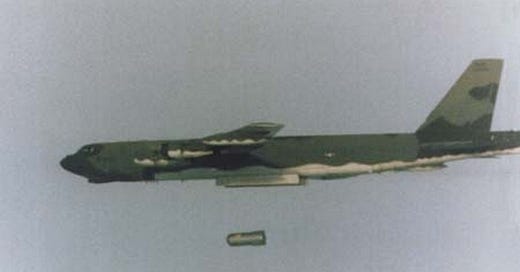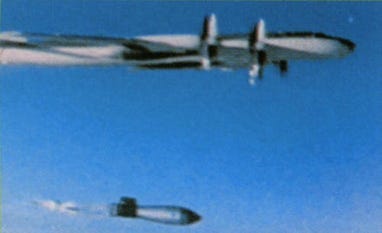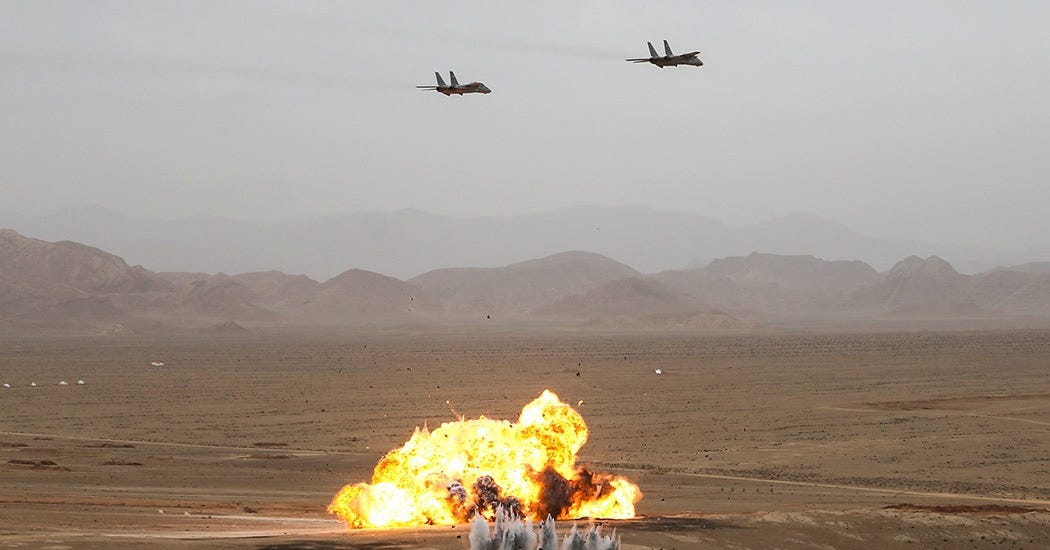The USA and USSR Used to Target Underground Facilities With Massive Nuclear Bombs
Precision be damned
by STEVE WEINTZ
The U.S. military may be readying its arsenal of deep-burying, fortification-smashing, non-nuclear bombs for a possible attack on Iranian nuclear sites.
American bunker-busters are big, to be sure—30,000 pounds for one model. But until the 1990s, the USA relied on much more powerful nuclear weapons for destroying buried targets. And the Soviet Union had an even grander device.
In 2011, the Pantex plant in Texas completed dismantling one of the last Cold War monsters, an early-1960s-vintage U.S. Air Force B-53 nuclear gravity bomb.
Using the same “physics package” as the Titan II ICBM warhead, the 12-foot-long B-53 was fitted with huge parachutes and an aluminum-honeycomb crumple zone; its nine megatons of fission and fusion power could pulverize granite mountains and reduce whole cities to radioactive ash.
Within strategic-arms treaties, the Pentagon managed retain a few in reserve until the late 1990s—when smaller, more accurate nuclear and conventional weapons were deployed in the same bunker-busting role.
The B-53 had a venerable pedigree, tracing its design lineage back to the very first solid-fuel radiation implosion device ever tested, the 15-megaton Shrimp exploded in the 1954 Castle Bravo test.
The Soviets had their own, even bigger munition: the Tsar of Bombs, or “Big Ivan” as it was known to its creator Andrei Sakharov.
Big Ivan
Soviet premier Nikita Khrushchev ordered several nuclear spectacles to be staged during U.S. Pres. John F. Kennedy’s first year in office in 1961, and Sakharov’s 100-megaton bomb was to be the climax.
No bomb so gigantic had yet been designed or tested, but when the premier notified the world of the forthcoming test, to commemorate the October Revolution, Sahkarov and his team got cracking. You did not want to fail Khrushchev.
The team decided to substitute inert lead for uranium in the third-stage tampers; this cut the bomb’s yield in half, but also greatly reduced the fallout, which could have boosted atmospheric radioactivity by 25%.
In fewer than 10 months, the Arzamas-16 weaponeers developed and built an enormous device as large as a small tank—a bomb so big that the Bison bomber to carry it required radical surgery on its bomb bay in order to fit just part of the 26-foot weapon’s bulk inside the fuselage.
If anything displayed the military impracticality of such a weapon it was this, for the slow turboprop Bear was slowed further by drag and maximum payload. There was no target in Western Europe big enough to merit such a blow, even if the lumbering Bear made it through air-defenses.
Big Ivan was released over the Novaya Zemlya Test Range on Oct. 30, 1961 and exploded at 13,000 feet. The detonation was measured at 57 megatons and produced a magnitude-5 earthquake.
Everything was obliterated out to 16 miles from ground zero, everything knocked flat out to 30 miles. Unprotected observers could have received 3rd-degree burns over 60 miles away.
The microscopic remains of Big Ivan are embedded in the bones of everyone alive on Earth at that time. Fortunately, today the destruction of buried targets such as Iran’s nuclear sites is a much more surgical affair.
Read more:








And the reason Israel wants us to participate, is because they don’t have the heavy bombers needed to carry this massive non-nuclear bunker busting bomb of ours.
Love the props.
In Russia, the you don’t drop the bomb. The bomb drops you.